Snob Feeding
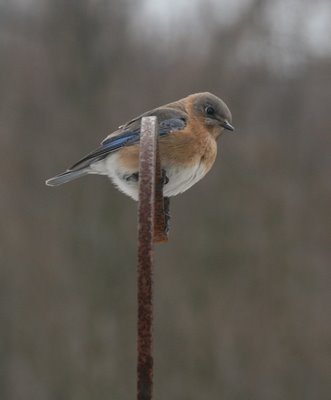 A suet dough fan at the back deck (female eastern bluebird). I post these just to show you that I am capable of taking a decent bird picture.
A suet dough fan at the back deck (female eastern bluebird). I post these just to show you that I am capable of taking a decent bird picture.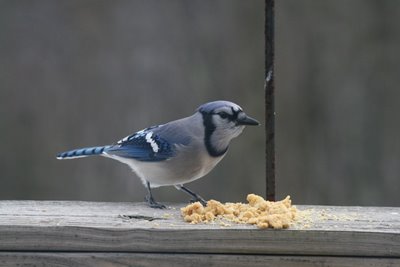 Blue jays are prone to gobbling great quantities of dough, but I don't mind it. They're just bearing it away to cache it for later. Sometimes I give them the bum's rush when I think they've taken enough. But I adore them and they know it. Well, that's enough of good bird photos. On to the crappy ones.
Blue jays are prone to gobbling great quantities of dough, but I don't mind it. They're just bearing it away to cache it for later. Sometimes I give them the bum's rush when I think they've taken enough. But I adore them and they know it. Well, that's enough of good bird photos. On to the crappy ones.It's that time of winter, when the cold clamps down and supplies of natural bird food are dwindling. As I write, the temperature is plunging through the twenties, despite brilliant sun and blue sky. Tonight's going to be in the single digits, brrrr!
When the ground freezes, European starlings come in hordes to my feeders. I am an unrepentant snob when it comes to feeding good suet dough to starlings. Hence my newly coined term, "Snob feeding." If the starlings would just take a little food and leave, like all the rest of the birds do, that would be fine. But starling style (dare I call it Eurostyle?) is to descend in a pack of a dozen or more, crowd, squabbling, into the dish, and vacuum up every bit of food. Before they depart, they unload the foul contents of their caecums into the food dish for me to clean up. (No, clearly I dare not.) What doesn't go into the dish goes all over our front stoop. They sit all day in the sumac on our north border and watch for me to put out more food, and they try to beat the bluebirds, Carolina wrens, cardinals, titmice and woodpeckers to it. Usually, they succeed. If starlings weren't exotic birds, and so aggressive and abundant, I'd probably put up with their gluttony. But the filth they leave everywhere puts me over the edge.
Making suet dough is enough work, especially when I'm mixing up the recipe times ten, that this starling problem had to be addressed. So, taking the advice I hand out so freely to others, I got out my so-called "bluebird feeders" and once again tried to make them work to everyone's advantage but the starlings'.
This Plexi-sided feeder has proven to be an unequivocal flop. It's a great looking feeder, a nice concept, and I'm sure that somewhere on Planet Earth, there are happy bluebirds and chickadees going in and out of a feeder just like this one. However...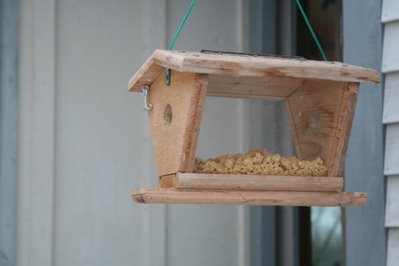 I've been trying to entice birds to use it for five years now, and I have never had a single bird, blue or otherwise, enter it via the entrance holes in each side. Cardinals perch on the side railings and peer forlornly at the dough locked within. Chances that a cardinal would enter a hole are nil, anyway. Carolina wrens peek and lean in, occasionally snagging a morsel. I think it's because it looks like some kind of trap. It's been hanging up for two weeks now, stuffed with suet dough, and the most action it's gotten is a pair of tufted titmice, perching and peeking in one hole. But as bold and innovative as titmice are, neither one has dared enter. One year I put it out and found the same results after a couple of weeks. So I opened up the hinged top, and birds would hop down inside it to get suet dough. But that defeats the purpose, which is to exclude birds that can't enter a 1 1/2" hole. So I reluctantly give this feeder an F, and will consign it to eternity.
I've been trying to entice birds to use it for five years now, and I have never had a single bird, blue or otherwise, enter it via the entrance holes in each side. Cardinals perch on the side railings and peer forlornly at the dough locked within. Chances that a cardinal would enter a hole are nil, anyway. Carolina wrens peek and lean in, occasionally snagging a morsel. I think it's because it looks like some kind of trap. It's been hanging up for two weeks now, stuffed with suet dough, and the most action it's gotten is a pair of tufted titmice, perching and peeking in one hole. But as bold and innovative as titmice are, neither one has dared enter. One year I put it out and found the same results after a couple of weeks. So I opened up the hinged top, and birds would hop down inside it to get suet dough. But that defeats the purpose, which is to exclude birds that can't enter a 1 1/2" hole. So I reluctantly give this feeder an F, and will consign it to eternity.
 I've been trying to entice birds to use it for five years now, and I have never had a single bird, blue or otherwise, enter it via the entrance holes in each side. Cardinals perch on the side railings and peer forlornly at the dough locked within. Chances that a cardinal would enter a hole are nil, anyway. Carolina wrens peek and lean in, occasionally snagging a morsel. I think it's because it looks like some kind of trap. It's been hanging up for two weeks now, stuffed with suet dough, and the most action it's gotten is a pair of tufted titmice, perching and peeking in one hole. But as bold and innovative as titmice are, neither one has dared enter. One year I put it out and found the same results after a couple of weeks. So I opened up the hinged top, and birds would hop down inside it to get suet dough. But that defeats the purpose, which is to exclude birds that can't enter a 1 1/2" hole. So I reluctantly give this feeder an F, and will consign it to eternity.
I've been trying to entice birds to use it for five years now, and I have never had a single bird, blue or otherwise, enter it via the entrance holes in each side. Cardinals perch on the side railings and peer forlornly at the dough locked within. Chances that a cardinal would enter a hole are nil, anyway. Carolina wrens peek and lean in, occasionally snagging a morsel. I think it's because it looks like some kind of trap. It's been hanging up for two weeks now, stuffed with suet dough, and the most action it's gotten is a pair of tufted titmice, perching and peeking in one hole. But as bold and innovative as titmice are, neither one has dared enter. One year I put it out and found the same results after a couple of weeks. So I opened up the hinged top, and birds would hop down inside it to get suet dough. But that defeats the purpose, which is to exclude birds that can't enter a 1 1/2" hole. So I reluctantly give this feeder an F, and will consign it to eternity.This little feeder is somewhat more successful. The principle is that it excludes all birds that can't or won't enter through the 1 1/2" square wire mesh holes. 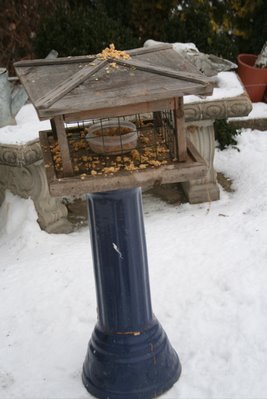 It's a little more user friendly, since the bird doesn't have to squeeze through a hole and enter a completely enclosed area. After a couple of days of sitting unused, a pair of Carolina wrens and a couple of titmice learned to use it. The starlings also figured out that if they stuck their heads inside and stretched their necks all the way out they could vacuum up all the suet dough. Putting the dough in a small plastic dish in the center solved this. But a problem remained: Cardinals, woodpeckers, juncoes and the bluebirds I was trying to entice refused to go inside. In past years I've had bluebirds enter this feeder successfully. It's a matter of giving them time to get used to it. So this feeder was marginally successful, but nothing to write home about, because it's just too small all around to completely defeat the starlings. I often wonder if feeder manufacturers bother to give prototypes to people like me who can test them before going into production. Apparently not, in many cases. The small size of most feeders available today has to do not with utility or efficacy, but solely with whether or not they'll fit on store shelves. Starlings have a reach of more than three inches by just stretching their necks, and this little feeder encloses an area about 9 x 9". So there's a three-inch "safe zone" at the very center of the inside. Hmmph.
It's a little more user friendly, since the bird doesn't have to squeeze through a hole and enter a completely enclosed area. After a couple of days of sitting unused, a pair of Carolina wrens and a couple of titmice learned to use it. The starlings also figured out that if they stuck their heads inside and stretched their necks all the way out they could vacuum up all the suet dough. Putting the dough in a small plastic dish in the center solved this. But a problem remained: Cardinals, woodpeckers, juncoes and the bluebirds I was trying to entice refused to go inside. In past years I've had bluebirds enter this feeder successfully. It's a matter of giving them time to get used to it. So this feeder was marginally successful, but nothing to write home about, because it's just too small all around to completely defeat the starlings. I often wonder if feeder manufacturers bother to give prototypes to people like me who can test them before going into production. Apparently not, in many cases. The small size of most feeders available today has to do not with utility or efficacy, but solely with whether or not they'll fit on store shelves. Starlings have a reach of more than three inches by just stretching their necks, and this little feeder encloses an area about 9 x 9". So there's a three-inch "safe zone" at the very center of the inside. Hmmph.
There had to be some other solution, given that the "bluebird feeders" I have are both failures, from a number of standpoints.
 It's a little more user friendly, since the bird doesn't have to squeeze through a hole and enter a completely enclosed area. After a couple of days of sitting unused, a pair of Carolina wrens and a couple of titmice learned to use it. The starlings also figured out that if they stuck their heads inside and stretched their necks all the way out they could vacuum up all the suet dough. Putting the dough in a small plastic dish in the center solved this. But a problem remained: Cardinals, woodpeckers, juncoes and the bluebirds I was trying to entice refused to go inside. In past years I've had bluebirds enter this feeder successfully. It's a matter of giving them time to get used to it. So this feeder was marginally successful, but nothing to write home about, because it's just too small all around to completely defeat the starlings. I often wonder if feeder manufacturers bother to give prototypes to people like me who can test them before going into production. Apparently not, in many cases. The small size of most feeders available today has to do not with utility or efficacy, but solely with whether or not they'll fit on store shelves. Starlings have a reach of more than three inches by just stretching their necks, and this little feeder encloses an area about 9 x 9". So there's a three-inch "safe zone" at the very center of the inside. Hmmph.
It's a little more user friendly, since the bird doesn't have to squeeze through a hole and enter a completely enclosed area. After a couple of days of sitting unused, a pair of Carolina wrens and a couple of titmice learned to use it. The starlings also figured out that if they stuck their heads inside and stretched their necks all the way out they could vacuum up all the suet dough. Putting the dough in a small plastic dish in the center solved this. But a problem remained: Cardinals, woodpeckers, juncoes and the bluebirds I was trying to entice refused to go inside. In past years I've had bluebirds enter this feeder successfully. It's a matter of giving them time to get used to it. So this feeder was marginally successful, but nothing to write home about, because it's just too small all around to completely defeat the starlings. I often wonder if feeder manufacturers bother to give prototypes to people like me who can test them before going into production. Apparently not, in many cases. The small size of most feeders available today has to do not with utility or efficacy, but solely with whether or not they'll fit on store shelves. Starlings have a reach of more than three inches by just stretching their necks, and this little feeder encloses an area about 9 x 9". So there's a three-inch "safe zone" at the very center of the inside. Hmmph.There had to be some other solution, given that the "bluebird feeders" I have are both failures, from a number of standpoints.
I decided to use the starling's natural (and well-founded) fear of humans to my advantage. I'd feed suet dough only when I was in the kitchen to watch it. This is easy enough to do, since I'm in the kitchen for a couple of hours in the morning and a couple in the evening, fixing lunches and breakfasts, cooking dinner. I put my birdbath pedestal on top of my bonsai bench, which stands just beneath the kitchen window. I put the suet dough dish on top of that, neatly bringing it up to window level. This is a great arrangement, since the whole affair is under the eave, which keeps the food dry. The dish is snugged right up against the kitchen window, which means that I am about two feet away from it. And I make a terrific scarecrow.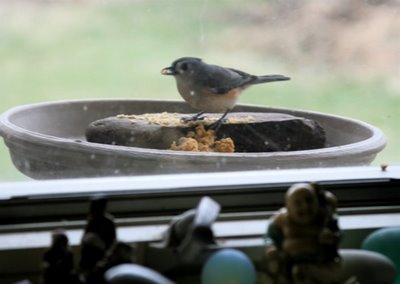 Tufted titmice are usually the first to try anything around here. They're inquisitive, smart, and bold. But even the juncoes and song sparrows are becoming accustomed to the new arrangement.
Tufted titmice are usually the first to try anything around here. They're inquisitive, smart, and bold. But even the juncoes and song sparrows are becoming accustomed to the new arrangement.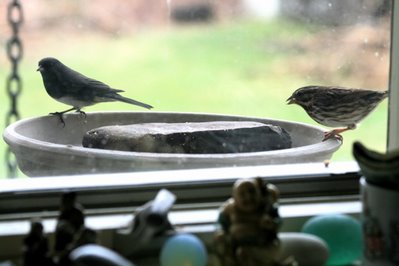 My first Carolina chickadee at the new location.
My first Carolina chickadee at the new location.  Yes, it's me. The Dough Lady. You know me. Don't look so spooked.
Yes, it's me. The Dough Lady. You know me. Don't look so spooked.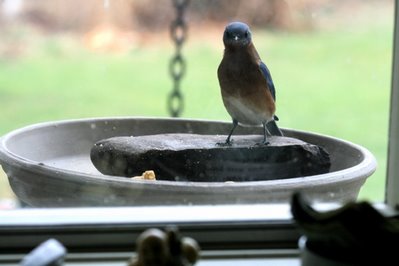 At first, the birds all avoided the dish, but I was patient. I knew that my true friends would come to accept it if I would only wait. At first, they only came in ones and twos, and only when I was out of the kitchen. About ten days into it, I'm delighted to report that most of the birds are now using the "snob feeder" when I'm in the kitchen, especially if the kitchen lights are off. Titmice and cardinals will come when I'm standing right at the window, and the bluebirds are rapidly acclimating to me as well. Hey, it's not like they don't know who I am. These are the same birds that stare me down, begging shamelessly, when I'm writing in the tower. They know darn well who I am, and they know that I'm the person who puts the dough out for them. And they're cool with it. We're friends.
At first, the birds all avoided the dish, but I was patient. I knew that my true friends would come to accept it if I would only wait. At first, they only came in ones and twos, and only when I was out of the kitchen. About ten days into it, I'm delighted to report that most of the birds are now using the "snob feeder" when I'm in the kitchen, especially if the kitchen lights are off. Titmice and cardinals will come when I'm standing right at the window, and the bluebirds are rapidly acclimating to me as well. Hey, it's not like they don't know who I am. These are the same birds that stare me down, begging shamelessly, when I'm writing in the tower. They know darn well who I am, and they know that I'm the person who puts the dough out for them. And they're cool with it. We're friends.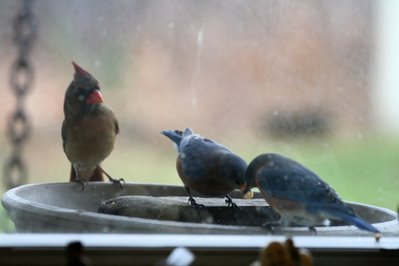
I really like it when the bluebirds feel comfortable enough to turn their backs on me. That is something I can assure you the starlings NEVER do. A subtle refinement of this new system is to pile the suet dough on the side of the dish nearest the window, so the birds have to come right up against the glass to feed. The starlings don't like that, and I have seen only one house sparrow venture on this feeder. That's saying something.
I really like it when the bluebirds feel comfortable enough to turn their backs on me. That is something I can assure you the starlings NEVER do. A subtle refinement of this new system is to pile the suet dough on the side of the dish nearest the window, so the birds have to come right up against the glass to feed. The starlings don't like that, and I have seen only one house sparrow venture on this feeder. That's saying something.
The starlings are not cool with feeding two feet away from me. I make horrible faces and lunge at them should they be so bold. This photo was taken while I was standing well back from the window in the darkened kitchen, and just a millisecond before I yelled BLAAA! and waved my arms. The starlings didn't come back for the rest of the morning.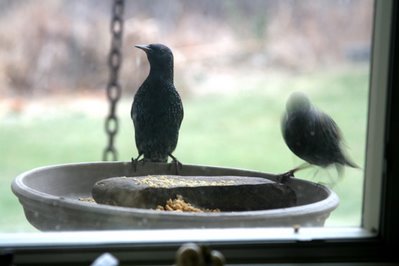 I have to laugh, because when I drive up from being in town, the "snob feeder" is full of starlings. They know when I'm away and take that opportunity to clean up all the food. But they're decidedly uncomfortable with eating in front of me. They get strong negative reinforcement when they dare. And I actually have suet dough left in the dish at dusk.
I have to laugh, because when I drive up from being in town, the "snob feeder" is full of starlings. They know when I'm away and take that opportunity to clean up all the food. But they're decidedly uncomfortable with eating in front of me. They get strong negative reinforcement when they dare. And I actually have suet dough left in the dish at dusk.
For now, two weeks into it, this is working well. I get ridiculously close looks at all my favorite birds. They get good food, unmolested by starlings. I don't have to wash the dish twice a day. My suet dough output has gone from over a pound a day to about 1/3 pound. That's as it should be. What's the sense of putting expensive, labor-intensive bird food out and not hanging around to see who eats it? When you think about it, it makes sense to feed a premium food like this in a highly structured way, at the same time of day. That way, the birds you want to attract learn when it's available, and the birds you don't want have to lump it, because you're there guarding it. The system is based on snobbery, on the natural spookiness of starlings, and on the bond of trust I've built with the birds I feed. Snob feeding.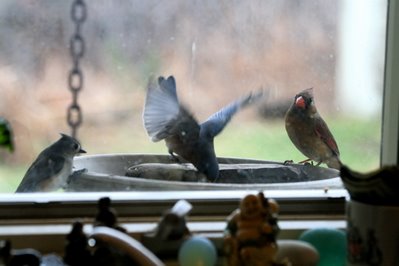
Action like this right by your kitchen window is its own reward. I know these pictures are awful, but it was the darkest rainy day ever, and I haven't had a chance to get up and clean the outside glass. I just had to show you what all goes on now outside my window as I'm cooking and washing dishes.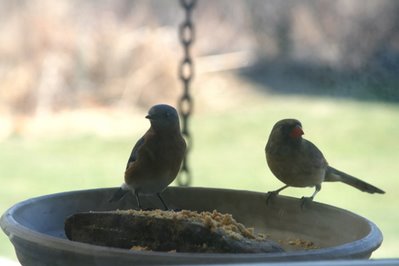 As you can see, sunny days are worse yet for photography! This is a bluebird with a cardinal.
As you can see, sunny days are worse yet for photography! This is a bluebird with a cardinal.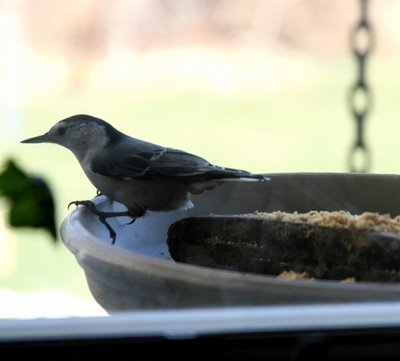 Check out the hind toe length on this white-breasted nuthatch. Nice hook to hang by.
Check out the hind toe length on this white-breasted nuthatch. Nice hook to hang by.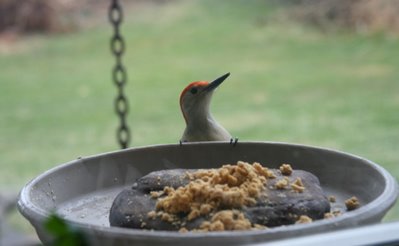 How nice to see Mr. Redbelly conquer his shyness! Help yourself! We're all friends here at Birdie Cheers.
How nice to see Mr. Redbelly conquer his shyness! Help yourself! We're all friends here at Birdie Cheers.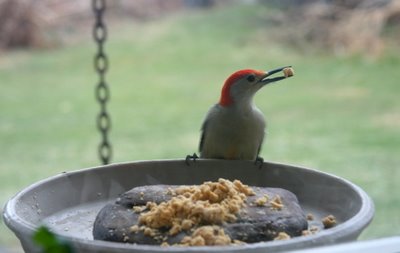
If you're around at predictable times a day, and you're having trouble with starlings eating all your good Zick dough,** you might want to try something like this. A large, high-quality cage excluder feeder is a good place to start. But it's really rewarding to train the birds you like most to trust you and eat in your presence. And they'll like you, and trust you right back.
**There. I wrote it. I still have to suppress a startled "Waaak!" when I see people I've never met calling it Zick Dough on their blogs. I keep forgetting that we're all out there, introducing ourselves, every day.
Action like this right by your kitchen window is its own reward. I know these pictures are awful, but it was the darkest rainy day ever, and I haven't had a chance to get up and clean the outside glass. I just had to show you what all goes on now outside my window as I'm cooking and washing dishes.
If you're around at predictable times a day, and you're having trouble with starlings eating all your good Zick dough,** you might want to try something like this. A large, high-quality cage excluder feeder is a good place to start. But it's really rewarding to train the birds you like most to trust you and eat in your presence. And they'll like you, and trust you right back.
**There. I wrote it. I still have to suppress a startled "Waaak!" when I see people I've never met calling it Zick Dough on their blogs. I keep forgetting that we're all out there, introducing ourselves, every day.
Labels: bluebird feeders, excluding starlings, feeding bluebirds, Starlings, suet dough for birds, Zick dough





